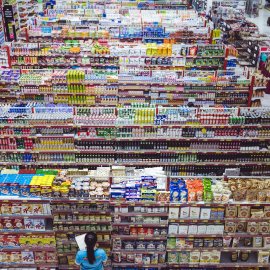Certify Water
-
English
-
ListenPause
[intro music] Welcome to World Ocean Radio… I’m Peter Neill, Director of the World Ocean Observatory. In my book, THE ONCE AND FUTURE OCEAN, I argue for greater public understanding of how we consume water, how we price water, and how we manage water as the single most important resource on earth and as the key component in any new paradigm for value, structure, and behavior in the 21st century. I use as one example the image of walking down a supermarket aisle and hearing a torrent of cascading water in untold volume used for the processing, packaging, and distribution of the products found on the shelves. Water is a fundamental externality in the financing of production, rarely calculated into the price in that it is often free or heavily subsidized for the manufacturer and incidental to specific accounting for the specific product. Thus, the true cost of the most important resource, not just to the making of one item or another, but to the overall availability of the water consumed to the larger needs of society – drinking water, sanitation, irrigation, and much, much more – is left out of the financial equation. To provide an example, this morning I took from the shelf a paper package of Imagine Natural Creations tomato bisque soup. It was covered with notifications and labels – USDA Certified Organic by Quality Assurance International; recyclable ONLY where facilities exist; Forest Sustainability Council MIX certification of paperboard from responsible sources; further assertion that the product within was organic, contained non-GMO ingredients. The nutrition facts were comprehensive. Finally, the ingredients were listed. Indeed, the package declares an exhausting awareness and purposeful dedication to the health of its consumers. The good people at Imagine Natural Creations are to be congratulated for their concern and commitment. But what was missing from all this information? How much water was used in the growing of those tomatoes? How much water was used in the processing and the making? How was the water waste from production treated and disposed of? Where did the water come from and was its availability subsidized by the costs of public treatment and distribution? Do any of the certifications cited include water use in the criteria applied? How much water was used in the production of the packaging, the distribution of the product, the continuous progress from raw ingredient to point of sale? The real point here is that the most important component remains hidden: an unarticulated value—positive and negative—that might enter our calculation of its desirability for consumption. Would it not be as useful to know a rating of water use against that of a competitor as much as the use of salt? If we are concerned about GMO ingredients and demand such labeling from our legislators as a public responsibility, why should we not be equally concerned about water consumption labeling with equal and immediate impact on our individual and public health? Would it not be a constructive project for one of our water-directed institutes, concerned with critical water availability, to move for the voluntary, even legislative adoption of such information to be listed not just on food products but on every product and its packaging, from smart phones to computers to automobiles, from metal, paper and wood products, iron, steel, and aluminum, from fracking to the cooling of nuclear generators and our houses and offices, from the growing of all things and from all beverages imbibed. Truth in labeling. It’s time for us to know and publicly declare how the circles and cycles of water work on our consummate behalf and how we must protect and recycle that essential value as the key ingredient in our future sustenance. Let’s certify water! We will discuss these issues, and more, in future editions of World Ocean Radio. [outro music]
There are numerous examples of the ways that water consumption and use go unseen in our daily lives. From clothing to food, from paper to metal and wood products, from packaging to smart phones, automobiles to energy extraction, and so much more. In this episode of World Ocean Radio we argue for the ways that water use and consumption should be rated and labeled on every product we consume as a means to calculate the true cost of the most important and valuable resource on earth.
About World Ocean Radio
Since 2009, a weekly 5-minute podcast covering a broad spectrum of ocean issues from science and education to advocacy and exemplary projects. World Ocean Radio, a project of the World Ocean Observatory is available for syndicated use at no cost by college and community radio stations worldwide. Contact [email protected] if you are interested in becoming an affiliate or know of a radio station that should be broadcasting these episodes each week.
Image
Market in Ubud, Indonesia
Bernard Hermant
@bernardhermant
- Login to post comments



